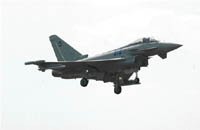Singapore's decision to drop one of the three contenders for its Next Generation Fighter requirement only months before a final decision is expected was not only unexpected but has left the bidding team looking for answers to some searching questions.
Eurofighter GmbH and BAE Systems had some reason to be optimistic after the Typhoon reportedly 'won' the Republic of Singapore Air Force (RSAF) evaluation.
This was not a competitive fly-off, and was only one element in a broad evaluation, but the Typhoon demonstrated impeccable serviceability. It was able to delivery everything they wanted, including supercruise, when its competitors could not. Radar performance was reportedly far in excess of what Singapore had expected to see, and the aircraft was able to climb to operating altitude without making a tortuous series of turns to avoid Malaysian air space.
Neither the Typhoon, nor the Dassault Rafale, nor the Boeing F-15 can meet the RSAF's requirements in their present form. But there was every reason to believe that the Typhoon in its Tranche 2+ configuration could meet - and comfortably exceed - Singapore's requirement.
The fact that Eurofighter GmbH was able to fly Singaporean pilots in the active cockpit, demonstrating the planned capabilities and enhancements in a realistic simulated sortie, reportedly impressed the evaluation team. By the end of the evaluation phase, the Typhoon was, apparently, the RSAF's favoured technical solution.
The aircraft was then rejected before either of its competitors, showing that it not only 'failed to win', but that it had become the 'third choice.'
It is believed that the decision had little, if anything, to do with the Typhoon's capability and planned capability per se, but was instead a natural reaction to what insiders called "a shambolic performance" by BAE Systems during the early part of the bidding process. It also apparently reflected Singaporean unease about the risks surrounding the advanced Tranche 2 capabilities it required.
In particular, the Singaporeans were concerned about delivery timescales and were said to be worried by the continuing inability by the Eurofighter partner nations to finally define the Tranche 2 and Tranche 3 Typhoon specifications.
Singapore wanted a delivery timescale that could "just about have been met with Tranche 1 aircraft", but required Tranche 2 capabilities that are "road-mapped" but still unfunded, and whose development has not yet been started. Only a basic air-to-ground capability (using the Litening 3 laser designator and enhanced Paveway LGBs) has been set in stone, and this falls far short of the capability required by the RSAF.
Confidence in the Typhoon's future capabilities may have been undermined by continuing doubts about the programme's long-term future, with Britain's Chief of the Air Staff casting doubt on Britain's need for Tranche 3, and with the Liberal Democrat party seizing on cancellation of the project in the recent UK general election.
BAE insiders say that while in days gone by BAE had a formidable reputation for putting together watertight bids, with a highly-regarded bid centre and "red teams", these withered after the merger with GEC. By the time the Typhoon campaign in Singapore began, the company no longer had the structures in place to put together a winning bid, with a sensible price and a convincing technical specification.
Belatedly recognising this, one of the company's remaining marketing gurus (who had reportedly been responsible for the biggest recent Hawk sales successes) was drafted in to oversee the bid last autumn, and a price and specification was submitted to the Singaporeans in February.
Sources close to the bid have been scathing about BAE Systems and UK MoD middle/senior management, who are said to have been inefficient, obstructive or unhelpful to the bid team, though dealings with industry in the other three partner nations have reportedly been trouble-free.
Others criticised industry's commercial performance, and compared it with Dassault's "hunger". The French bid was made by one government and one contractor, working closely together with a real need for a sale, and willing to make some offers which a consortium of four nations/industries, with a huge Tranche 2 order book already in place, were unable or unwilling to make.
After a week of frantic media speculation, Singapore's MINDEF confirmed that it had "narrowed down the selection for the next fighter replacement programme to Dassault's Rafale and Boeing's F-15" and that it had "decided not to consider the proposal from BAE Systems any further."
It added that the Typhoon was a "very capable aircraft", but pointed out that "the committed schedule for the delivery of the Typhoon and its systems did not meet the requirements."
Eurofighter GmbH has officially denied that there were any problems with the bid, and chief executive Aloysius Rauen praised BAE Systems, Rolls-Royce, the UK government, Procurement Minister Lord Bach, the RAF, and DESO for their "excellent support".
There seems to be a new willingness in the consortium to offer greater flexibility, and to consider the early adoption of particular capabilities to meet the requirements of export customers, after the failed Singapore bid.
BOXTEXT: 'It is believed that the decision had little, if anything, to do with the Typhoon's capability and planned capability per se, but was instead a natural reaction to what insiders called "a shambolic performance" by BAE Systems during the early part of the bidding process.'

Source: Flight Daily News
















